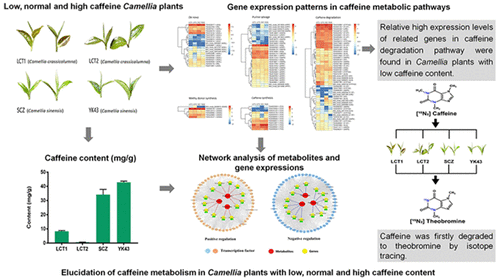当前位置:
X-MOL 学术
›
J. Agric. Food Chem.
›
论文详情
Our official English website, www.x-mol.net, welcomes your
feedback! (Note: you will need to create a separate account there.)
Caffeine Content and Related Gene Expression: Novel Insight into Caffeine Metabolism in Camellia Plants Containing Low, Normal, and High Caffeine Concentrations
Journal of Agricultural and Food Chemistry ( IF 5.7 ) Pub Date : 2019-03-04 00:00:00 , DOI: 10.1021/acs.jafc.9b00240 Biying Zhu 1 , Lin-Bo Chen 2 , Mengqian Lu 1 , Jing Zhang 1 , Jieyun Han 1 , Wei-Wei Deng 1 , Zheng-Zhu Zhang 1
Journal of Agricultural and Food Chemistry ( IF 5.7 ) Pub Date : 2019-03-04 00:00:00 , DOI: 10.1021/acs.jafc.9b00240 Biying Zhu 1 , Lin-Bo Chen 2 , Mengqian Lu 1 , Jing Zhang 1 , Jieyun Han 1 , Wei-Wei Deng 1 , Zheng-Zhu Zhang 1
Affiliation

|
Caffeine is a crucial secondary metabolic product in tea plants. Although the presence of caffeine in tea plants has been identified, the molecular mechanisms regulating relevant caffeine metabolism remain unclear. For the elucidation of the caffeine biosynthesis and catabolism in Camellia plants, fresh, germinated leaves from four Camellia plants with low (2), normal (1), and high (1) caffeine concentrations, namely, low-caffeine tea 1 (LCT1, Camellia crassicolumna), low-caffeine tea 2 (LCT2, C. crassicolumna), Shuchazao (SCZ, C. sinensis), and Yunkang 43 (YK43, C. sinensis) were used in this research. Transcriptome and purine alkaloids analyses of these Camellia leaves were performed using RNA-Seq and liquid chromatography–mass spectrometry (LC–MS). Moreover, 15N-caffeine tracing was performed to determine the metabolic fate of caffeine in leaves of these plants. Caffeine content was correlated with related gene expression levels, and a quantitative real-time (qRT) PCR analysis of specific genes showed a consistent tendency with the obtained transcriptomic analysis. On the basis of the results of stable isotope-labeled tracer experiments, we discovered a degradation pathway of caffeine to theobromine. These findings could assist researchers in understanding the caffeine-related mechanisms in Camellia plants containing low, normal, and high caffeine content and be applied to caffeine regulation and breeding improvement in future research.
中文翻译:

咖啡因含量和相关基因表达:对含有低,正常和高咖啡因浓度的茶花植物中咖啡因代谢的新见解
咖啡因是茶树中至关重要的次级代谢产物。尽管已经确定茶树中咖啡因的存在,但调节相关咖啡因代谢的分子机制仍不清楚。对于咖啡因的生物合成和分解代谢的阐明油茶加工厂,生鲜,从四个发芽叶茶花植株低(2),正常(1)和高(1)咖啡因浓度,即低咖啡因茶1(LCT1,本研究使用茶花茶,低咖啡因茶2(LCT2,C. crassicolumna),舒茶枣(SCZ,C. sinensis)和云康43(YK43,C. sinensis)。这些山茶花的转录组和嘌呤生物碱分析叶片使用RNA-Seq和液相色谱-质谱(LC-MS)进行分析。此外,进行了15次N-咖啡因追踪,以确定这些植物叶片中咖啡因的代谢命运。咖啡因含量与相关基因表达水平相关,特定基因的定量实时(qRT)PCR分析显示与获得的转录组学分析趋势一致。根据稳定的同位素标记示踪剂实验的结果,我们发现了咖啡因向可可碱的降解途径。这些发现可以帮助研究人员了解含有低,正常和高咖啡因含量的茶花植物中与咖啡因有关的机制,并将其用于咖啡因的调控和改良未来的研究中。
更新日期:2019-03-04
中文翻译:

咖啡因含量和相关基因表达:对含有低,正常和高咖啡因浓度的茶花植物中咖啡因代谢的新见解
咖啡因是茶树中至关重要的次级代谢产物。尽管已经确定茶树中咖啡因的存在,但调节相关咖啡因代谢的分子机制仍不清楚。对于咖啡因的生物合成和分解代谢的阐明油茶加工厂,生鲜,从四个发芽叶茶花植株低(2),正常(1)和高(1)咖啡因浓度,即低咖啡因茶1(LCT1,本研究使用茶花茶,低咖啡因茶2(LCT2,C. crassicolumna),舒茶枣(SCZ,C. sinensis)和云康43(YK43,C. sinensis)。这些山茶花的转录组和嘌呤生物碱分析叶片使用RNA-Seq和液相色谱-质谱(LC-MS)进行分析。此外,进行了15次N-咖啡因追踪,以确定这些植物叶片中咖啡因的代谢命运。咖啡因含量与相关基因表达水平相关,特定基因的定量实时(qRT)PCR分析显示与获得的转录组学分析趋势一致。根据稳定的同位素标记示踪剂实验的结果,我们发现了咖啡因向可可碱的降解途径。这些发现可以帮助研究人员了解含有低,正常和高咖啡因含量的茶花植物中与咖啡因有关的机制,并将其用于咖啡因的调控和改良未来的研究中。

















































 京公网安备 11010802027423号
京公网安备 11010802027423号